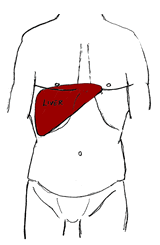The website is dedicated to Surgery of the Liver
Associated Sites: liver.org.uk | gallstones.co.uk | pancreaticcancer.co.uk
About the Liver
 |
| Diagram showing position of the liver |
The liver is the largest organ in the human body and it is situated in the right upper quarter of the abdominal cavity just under the right lower ribs. It extends from the right nipple to the costal margin (the lower border of the rib cage). A large part of the liver is protected by the right lower ribs.
Approximately a quarter of the blood of the body flows through the liver every minute. Like all other major organs in the body the liver receives a direct arterial blood supply via the hepatic artery. However in addition the liver has a second (dual) venous blood supply in that the blood that leaves the intestines (bowels) also flows through the portal vein and into the liver. All the blood entering the liver is collected up and eventually leaves the substance of the liver through three great hepatic veins.
The liver has a major role in dealing with the nutrient products of food digestion. It deals with drugs and other toxins absorbed via the intestines. It is involved in recycling red blood cells by breaking these down and one of the by products of this process is bile which plays a role in the digestion of fats. It produces essential proteins, clotting factors for the blood and it regulates cholesterol metabolism.
The liver is metabolically very active but despite this it is a remarkably resilient organ and the human body can withstand the loss of up to two thirds of the normal liver without the development of liver insufficiency. Following the loss of substantial liver volume the residual liver remnant will enlarge (hypertrophy). The discovery of this fact has made modern day liver surgery a reality.
Cancer of the large bowel is very common. Virtually all the blood that drains the large bowel enters the liver and it easy to understand why secondary bowel cancer might grow in the liver. Cancer cells may well be carried into the liver and implant here. Thereafter these cells may grow silently and develop into secondary tumours.